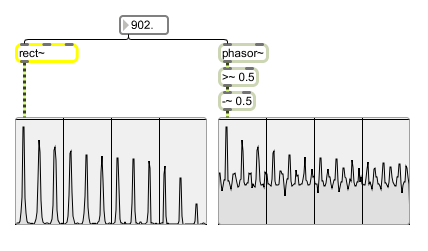Examples

Spectral comparison of rect~ and an ideal rectangular wave driven by a phasor~
Antialiased rectangular (pulse) oscillator
| Name | Type | Opt | Description |
|---|---|---|---|
| frequency and pulse-width | int or float | opt | First argument sets the initial frequency of the oscillator. The default is 0. Second argument sets the pulse width. The default is 0.5. |
| int | frequency [int] |
In left inlet: Sets the frequency of the oscillator. In middle inlet: Sets the pulse width of the oscillator. Signal is wrapped into the range 0-1. A value of 0.5 will produce a rectangular wave that spends equal amounts of time on the positive and negative edges of its cycle. |
| float | frequency [float] |
In left inlet: Sets the frequency of the oscillator. In middle inlet: Sets the pulse width of the oscillator. Signal is wrapped into the range 0-1. A value of 0.5 will produce a rectangular wave that spends equal amounts of time on the positive and negative edges of its cycle. |
| signal | In left inlet: Sets the frequency of the oscillator. In middle inlet: Sets the pulse width of the oscillator. Signal is wrapped into the range 0-1. A value of 0.5 will produce a rectangular wave that spends equal amounts of time on the positive and negative edges of its cycle. In right inlet: (optional) A sync signal. When the control signal crosses from below 0.5 to above 0.5, the oscillator resets itself. A phasor~ object works well for this purpose. The classic use is to set this control signal to your fundamental frequency and "sweep" the left frequency input in a range somewhere several octaves higher than the fundamental. |
|
| synctrig | sync-value (0 through 1) [float] |
The word followed by a floating-point number changes the value at which the object resets itself (i.e., when the input signal crosses from below the specified number to being above it, rect~ will reset itself). |
